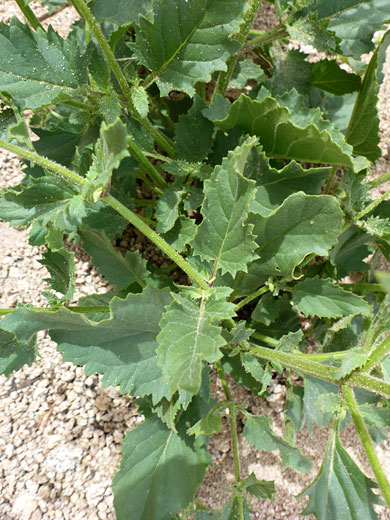Scrophularia Desertorum, Desert Figwort
Plants > Wildflowers > Scrophulariaceae > Scrophularia Desertorum
Common name:
Desert figwort
Family:
Scientific name:
Scrophularia desertorum
Main flower color:
Range:
California and Nevada
Height:
Up to 4 feet
Habitat:
Gravelly canyons, rocky places, dry hillsides; from 3,500 to 11,000 feet
Leaves:
Opposite, long-stalked; blades are ovate to broadly lanceolate or triangular, lined by large teeth; up to 4 inches long
Season:
April to August
Scrophularia desertorum occurs all along the Sierra Nevada and in the Great Basin Desert to the east, extending about half way across Nevada. Stems and leaves have a moderate to sparse covering of glandular hairs. Stems are square in cross-section, relatively stout and tall; up to four feet. Leaves are arranged in opposite pairs, most of the way along the stem, and adjacent pairs are rotated by 90 degrees. Leaves are dull yellow-green in color, with prominent veins, coarsely-toothed margins and a crinkled surface.
The inflorescence is an open, branched, elongated cluster, usually more densely glandular hairy than the stem. Flowers are formed of a five-lobed calyx, appressed to the corolla, which is slightly constricted in the middle, and opens to a two-lobed upper lip, deep red in color, and a three-lobed, creamy-pink lower lip. The middle lobe of the lower lip is strongly reflexed. Contained within the corolla are four stamens and one staminode (infertile stamen).
The inflorescence is an open, branched, elongated cluster, usually more densely glandular hairy than the stem. Flowers are formed of a five-lobed calyx, appressed to the corolla, which is slightly constricted in the middle, and opens to a two-lobed upper lip, deep red in color, and a three-lobed, creamy-pink lower lip. The middle lobe of the lower lip is strongly reflexed. Contained within the corolla are four stamens and one staminode (infertile stamen).
All Contents © Copyright The American Southwest | Comments and Questions | Contribute | Site Map




